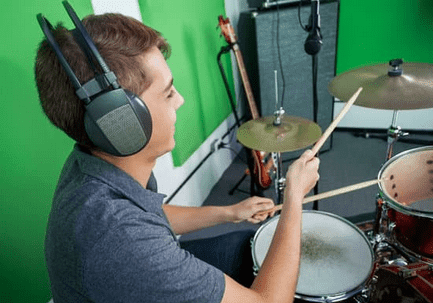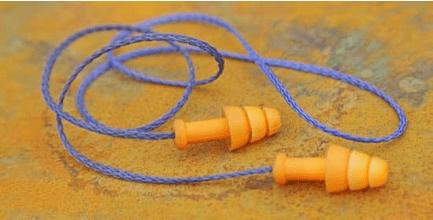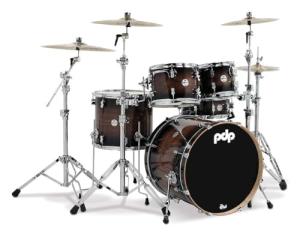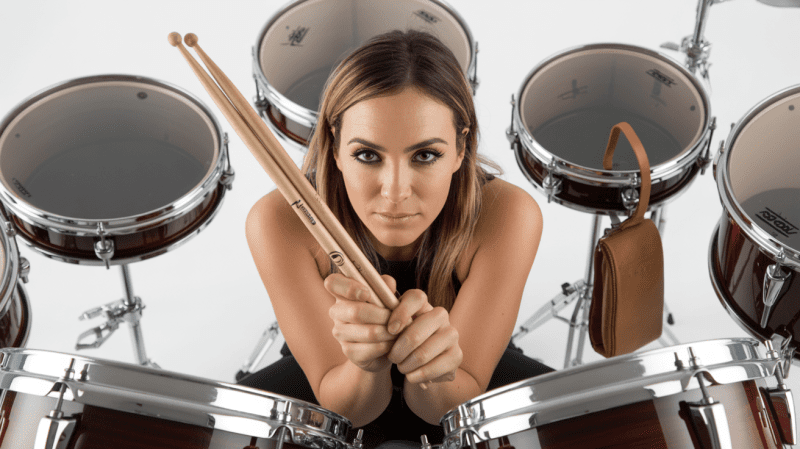Drummers put their hearing at risk every time they play. Sitting behind a drum kit means your ears get blasted with sound levels that can shoot well over 100 decibels—think chainsaw or jackhammer territory.
Long-term exposure to this kind of noise can wreck your hearing, trigger tinnitus, or even cause permanent loss if you skip protection.

Protecting your ears isn’t just about dodging future problems. It’s also about keeping your musical edge right now.
Many drummers don’t realize that hearing loss messes with how you perceive pitch, tone, and dynamics. The damage sneaks up slowly, usually without any warning signs until things get pretty bad.
The upside? There are actually some great hearing protection options made just for musicians.
From basic foam earplugs to fancy custom-molded plugs and in-ear monitors, you’ve got choices. These can knock down harmful noise levels but still let you hear yourself and your bandmates.
Key Takeaways
- Drummers get exposed to sound levels that can permanently damage hearing if they don’t use protection.
- Good ear protection keeps your hearing sharp and helps you stay on top of pitch and dynamics.
- There are plenty of options—from simple earplugs to high-tech monitors—that cut noise but keep things clear.
Understanding Hearing Health Risks for Drummers
Drummers deal with some brutal hearing health challenges. The sheer volume of sound during practice and gigs can do a number on the delicate parts of your inner ear.
Sources of Loud Noises in Drumming
Drum kits are some of the loudest instruments out there. Crash cymbals can hit 120-130 decibels if you’re up close—think jet engine levels. Snare drum hits usually break 110 decibels, and bass drums send out both big sounds and heavy vibrations.
Practice rooms can make things worse. Small, untreated spaces bounce sound around and crank up the volume even more. Add in amplified bandmates, and you’re really surrounded.
Electronic drums might seem safer, but not always. Many drummers just turn up their headphones too loud, trading one risk for another.
How Hearing Damage Occurs
Hearing damage from drumming usually comes from two main sources: sudden, super-loud hits and long stretches of high volume. Tiny hair cells in your inner ear convert sound into signals for your brain.
Loud sounds crush these hair cells. Once they’re gone, they don’t grow back—so hearing loss sticks around for good.
The damage builds up over time, often without you noticing until it’s too late.
The main risk factors look like this:
- Duration – Longer sessions mean more risk
- Volume – Louder playing causes faster damage
- Proximity – Sitting closer to drums increases the threat
- Frequency – Regular exposure with no breaks
Consequences of Untreated Hearing Loss
Hearing damage can really mess with a drummer’s life. Tinnitus—that ringing in your ears—often shows up first and can stick around forever. High-frequency hearing loss usually follows.
Musically, it’s a nightmare. You might miss certain frequencies, struggle to mix, or have trouble communicating with your band. Balancing instruments gets tricky.
Outside of music, conversations get tough, especially in noisy places like bars or clubs. Social isolation creeps in, and frustration builds.
Mental health can take a hit. There’s real evidence linking hearing loss with higher rates of depression and anxiety among musicians who can’t play or enjoy music like they used to.
Types of Ear Protection and Their Benefits

Drummers can pick from a bunch of hearing protection options, each with its own perks depending on the situation. The right gear can drop the noise to safer levels while letting you hear what matters.
Earplugs and Musician Earplugs
Basic foam earplugs are a cheap and easy way to start protecting your ears. They’re disposable, portable, and can cut sound by 20-33 decibels.
Musician earplugs are a step up. Unlike foam, they lower volume evenly across all frequencies, so the sound stays clear and natural. You still catch the details in your playing.
Custom-molded earplugs fit your ears perfectly. They’re made from impressions of your ears and feel comfortable even during long sessions. Lots of pros swear by these, especially the ones with a leash for convenience.
Reusable triple-flanged earplugs split the difference—they’re more durable than foam and sound better, but not quite as fancy as custom plugs.
Ear Muffs and Over-Ear Protection
Ear muffs block out a ton of noise, making them great for super loud environments. They cover your whole ear and create a solid barrier against high decibels.
Most drummer ear muffs have a noise reduction rating (NRR) between 22-33 decibels. Higher NRR means more protection.
They’re easy to take on and off between sets. Adjustable headbands help with comfort during long practices.
Some advanced models include electronics that let safe sounds through but block dangerous noise. Drummers stay aware of their surroundings without sacrificing safety.
In-Ear Monitors and Isolation Headphones
In-ear monitors (IEMs) protect your hearing and deliver a custom mix straight to your ears. You can hear yourself and the band without blasting the stage volume.
Custom-fit IEMs block out 25-30 decibels of outside noise. They seal your ear canal and keep distractions out.
Isolation headphones combine headphones and hearing protection. They usually cut outside noise by 20-25 decibels and work well with electronic kits, metronomes, or backing tracks.
Many pros like isolation headphones for practice since they keep sound quality up while protecting your ears. They’re especially handy for drummers who switch between acoustic and electronic kits.
Noise-Cancelling Headphones and Earbuds
Noise-cancelling tech uses microphones and electronics to sense outside sounds and cancel them out. This adds another layer of protection for drummers.
They’re great for travel and practicing with tracks. Many models use Bluetooth, so you’re not stuck with wires while playing.
Noise-cancelling earbuds are small and easy to lug around. Super handy for gigs and rehearsals.
But here’s the catch: noise-cancelling works best on steady, low-frequency sounds—not sudden drum hits. That’s why a lot of drummers double up, using both noise-cancelling headphones and earplugs for tough sessions.
Best Practices for Protecting Hearing While Drumming
Protecting your hearing takes more than just gear—it’s about habits and paying attention. Drummers who incorporate these strategies into their routine can continue playing for years without regret.
Monitoring Safe Sound Levels
Drummers need to know the sound pressure levels (SPL) they’re dealing with. A typical kit can pump out 90-130 dB, which is way above the safe limit of 85 dB.
Using a decibel meter app on your phone helps you track volume during practice. If you’re consistently over 85 dB, you need to cut back.
Time matters, too. The louder it gets, the less time you can safely play:
- 85 dB: 8 hours
- 94 dB: 1 hour
- 100 dB: 15 minutes
- 110 dB: less than 2 minutes
Take breaks every 45-60 minutes. Your ears need time to bounce back and avoid long-term damage.
Proper Fit and Comfort of Ear Protection
Good ear protection is non-negotiable. You’ve got options:
Foam earplugs: Cheap, but you need to roll and insert them right—pull your ear up, hold them until they expand.
Musicians’ earplugs: These have filters that drop volume but keep sound clear. Usually, they cut 15-25 dB and don’t mess with audio quality.
Custom-molded earplugs: Top-tier comfort for marathon sessions. They’re pricier but last for years and always fit right.
Fit is everything. Plugs should seal well but not hurt. If you feel pain or pressure, try a different size or type.
Effective Use of Monitoring Systems and Click Tracks
Modern monitoring systems let drummers hear themselves clearly without cranking the volume. In-ear monitors (IEMs) send a controlled mix straight to your ears and block out stage noise.
When you use IEMs:
- Keep the volume at 75-80% tops
- Go for custom-molded earpieces for better isolation
- Balance your mix so you don’t need to turn up certain parts
Click tracks should sit at a comfortable level—just loud enough to follow, not so loud you strain. Some drummers prefer the click to be a bit higher than the rest of the mix.
For practice, electronic drums with headphones give you control over volume and still feel satisfying to play.
Supporting Long-Term Hearing Health for Drummers
Protecting your ears isn’t just about slapping in earplugs for practice. You need a full-on strategy if you want to keep drumming for life.
Long-term hearing health means thinking ahead and building good habits, so you can keep your skills sharp through your whole career.
Regular Hearing Check-Ups with an Audiologist
Drummers should see a qualified audiologist for yearly hearing assessments. Audiologists can catch early signs of hearing damage, often before you even notice anything's wrong.
They'll use specialized equipment to measure hearing thresholds at different frequencies. With that information, they can provide advice tailored to your specific exposure and hearing health.
Most musicians first lose hearing in certain frequency ranges. Catching these changes early makes a real difference.
Audiologists often suggest custom-molded ear protection made just for musicians. These options usually feel more comfortable and sound more natural compared to generic earplugs.
Tinnitus Prevention and Management
Tinnitus—persistent ringing, buzzing, or hissing in the ears—hits a lot of drummers. The best way to avoid it is to always use hearing protection when playing.
If you're already dealing with tinnitus, you do have options:
- Sound therapy with white noise machines
- Cognitive behavioral therapy
- Relaxation techniques
- Tinnitus retraining therapy
It's also smart to protect your ears at concerts, sporting events, or when using power tools. Loud sounds outside of drumming sessions can add up fast.
Staying hydrated and maintaining good overall health may help alleviate symptoms. Some drummers even notice less tinnitus after cutting back on caffeine or alcohol—worth a try?
Education and Advocacy for Young Musicians
Young drummers pick up habits early that stick for life. Teaching them about hearing protection right away leads to better long-term hearing health.
Music teachers should include hearing health in their lessons. Schools can help by starting hearing conservation programs, which might include:
- Demonstrations on how to insert earplugs correctly
- Info about safe sound exposure limits
- Resources for affordable ear protection
Parents should ensure that their children have proper ear protection from the start. Kids' hearing is especially easy to damage.
Music stores can help, too put ear protection right next to the drums. That visual cue normalizes earplugs as standard gear for drummers.
Resources from the Hearing Health Foundation
The Hearing Health Foundation offers a range of resources specifically designed for musicians. Their website offers free materials on preventing noise-induced hearing loss.
They also sponsor research into new technology for protecting musicians' hearing without compromising the sound quality. It's worth keeping up with their updates.
Online hearing screenings from the foundation let drummers keep tabs on their hearing between check-ups. These tools can spot potential issues early.
Musicians can find hearing health pros who know the needs of performers in the foundation's directory. These specialists get what drummers go through.
Local chapters sometimes run workshops for musicians about hearing protection. It's a great opportunity to learn from experts and meet others who are passionate about their hearing.
Frequently Asked Questions
Drummers often have numerous questions about maintaining their hearing health. Concerns range from what gear to use to which habits make a difference over time.
What options are available for ear protection specifically designed for drummers?
There is a range of ear protection designed for drummers. Foam earplugs are inexpensive and readily available, typically costing just a few dollars for a pack.
Custom-molded earplugs fit your ears perfectly and typically sound better, but they can cost $100-$ 300. These are a favorite for serious players.
Musicians' earplugs with filters keep the sound balanced but quieter. In-ear monitors can also protect your ears and let you hear a custom mix.
How can drummers maintain their hearing health over time?
Take breaks during practice—5-10 minutes of quiet every hour helps your ears recover. It sounds simple, but it works.
Have your hearing checked by an audiologist on an annual basis. Catching problems early can save your hearing in the long run.
Manage your volume—move drums away from walls to avoid harsh reflections, and try low-volume practice pads or mesh heads for quieter sessions.
What are the differences between standard earplugs and specialized drummer ear protection?
Standard foam earplugs muffle high frequencies more than lows, leaving everything sounding dull. It's tough to hear the details in your playing that way.
Specialized earplugs for drummers use filters to lower the volume evenly across all frequencies. That way, you get a natural sound, just safer.
Drummer-specific options tend to feel more comfortable for long sessions and sometimes allow you to adjust the amount of sound they block.
Are there particular brands or types of ear protection recommended by professional drummers?
Pros often use Vic Firth, Hearos, or Earasers for earplugs made for musicians. These balance sound quality and protection nicely.
Custom-molded plugs from Westone or Ultimate Ears get high marks for comfort and protection. You can usually pick your filter strength, too.
Some drummers prefer electronic solutions, such as Vic Firth SIH2 headphones or in-ear monitors, which limit volume but maintain clear sound.
What should young or beginning drummers know about ear protection during practice and performances?
Start using ear protection from the very first day. Hearing loss is permanent, so it's better to build the habit early.
Parents and teachers should explain that earplugs don't block out all the sound—they make it safer. That helps kids accept wearing them.
New drummers sometimes find that ear protection makes it easier to focus on their technique, rather than just the loudness.
How do different ear protection devices affect the sound quality and perception for drummers?
Basic foam earplugs muffle high frequencies way more than low ones. That leaves everything feeling bass-heavy, which can easily mess with a drummer's sense of balance and dynamics.
They're honestly better than nothing, but let's be real not the best choice.
High-fidelity musician earplugs do a much better job. They preserve the sound spectrum while simply reducing the overall volume.
This means drummers get a more accurate idea of how they're playing, which is the whole point, right?
In-ear monitors take things even further. Drummers can dial in a perfect mix and tune out the outside noise almost completely.
Still, you need to set them up correctly, and the price can be a bit too high for some people.
Pacific by DW Concept Maple Exotic 5-Piece Shell Pack
Experience the magnificent sound and craftsmanship of the Pacific by DW Concept Maple Exotic 5-Piece Shell Pack available at our ecommerce store
Product information
$1,299.99
Product Review Score
4.17 out of 5 stars
216 reviews



